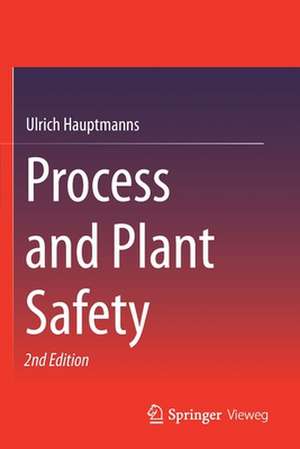Process and Plant Safety
Autor Ulrich Hauptmannsen Limba Engleză Paperback – 3 oct 2021
| Toate formatele și edițiile | Preț | Express |
|---|---|---|
| Paperback (2) | 716.94 lei 6-8 săpt. | |
| Springer Berlin, Heidelberg – 3 oct 2021 | 716.94 lei 6-8 săpt. | |
| Springer Berlin, Heidelberg – 10 sep 2016 | 962.81 lei 6-8 săpt. | |
| Hardback (1) | 970.39 lei 6-8 săpt. | |
| Springer Berlin, Heidelberg – 2 oct 2020 | 970.39 lei 6-8 săpt. |
Preț: 716.94 lei
Preț vechi: 843.45 lei
-15% Nou
Puncte Express: 1075
Preț estimativ în valută:
137.20€ • 148.98$ • 115.25£
137.20€ • 148.98$ • 115.25£
Carte tipărită la comandă
Livrare economică 23 aprilie-07 mai
Preluare comenzi: 021 569.72.76
Specificații
ISBN-13: 9783662614860
ISBN-10: 3662614863
Ilustrații: XVIII, 687 p. 229 illus., 16 illus. in color.
Dimensiuni: 155 x 235 mm
Greutate: 0.98 kg
Ediția:2nd ed. 2020
Editura: Springer Berlin, Heidelberg
Colecția Springer Vieweg
Locul publicării:Berlin, Heidelberg, Germany
ISBN-10: 3662614863
Ilustrații: XVIII, 687 p. 229 illus., 16 illus. in color.
Dimensiuni: 155 x 235 mm
Greutate: 0.98 kg
Ediția:2nd ed. 2020
Editura: Springer Berlin, Heidelberg
Colecția Springer Vieweg
Locul publicării:Berlin, Heidelberg, Germany
Cuprins
Introduction.- Hazardous Properties of Materials.- Exothermic and Pressure-Generating Reactions.- Safe Design and Operation of Plants.- Personal Safety and Personal Protective Equipment.- Safety of Process Plants by Process Control.- Protection of Equipment (End-of-pipe Technology).- Risk. -Investigation of Engineered Plant Systems.- Consequences of Accidents.- Functional Safety (Safety Integrity Levels).- Determination of Appropriate Distances Between Industry and Residential Areas.
Notă biografică
Ulrich Hauptmanns studied economics and nuclear engineering at the Universities of Berlin and Edinburgh. He obtained a doctor’s degree in nuclear reactor physics in Berlin and then worked as a safety analyst for the company constructing the German High Temperature Reactor THTR-300. After more than three years as visiting professor at the Department of Chemical Engineering of the University of Oviedo in Spain he joined the German government consultant for nuclear safety (GRS) in Cologne. His areas of work were engineering risks and probabilistic safety analyses for nuclear and process plants. Concurrently he taught at the Ruhr-University Bochum. In 1995 he was appointed to the chair of plant safety at the Otto-von-Guericke-University in Magdeburg, which he occupied until his retirement in 2011. Since then he has been working as a consultant on process and plant safety.
Textul de pe ultima copertă
Accidents in industrial installations are random events. Hence they cannot be totally avoided. Only the probability of their occurrence may be reduced and their consequences be mitigated. The book proceeds from hazards caused by materials and process conditions to indicating engineered and organizational measures for achieving the objectives of reduction and mitigation. Qualitative methods for identifying weaknesses of design and increasing safety as well as models for assessing accident consequences are presented. The quantitative assessment of the effectiveness of safety measures is explained. The treatment of uncertainties plays a role there. They stem from the random character of the accident and from lacks of knowledge of some of the phenomena to be addressed. The reader is acquainted with the simulation of accidents, with safety and risk analyses and learns how to judge the potential and limitations of mathematical modelling. Risk analysis is applied amongst others to “functional safety” and the determination of “appropriate distances” between industry and residential areas (land-use planning). This shows how it can be used as a basis for safety-relevant decisions. Numerous worked-out examples and case studies addressing real plants and situations deepen the understanding of the subjects treated and support self-study.
Target groups:
Chemical and petrochemical industry, licensing authorities, testing and certification bodies, safety engineers, engineering consultants, students of process, chemical and mechanical engineering as well as of industrial and engineering chemistry.
About the Author:Ulrich Hauptmanns studied economics and nuclear engineering at the Universities of Berlin and Edinburgh. He obtained a doctor’s degree in nuclear reactor physics in Berlin and then worked as a safety analyst for the company constructing the German High Temperature Reactor THTR-300. After more than three years as visiting professor at the Department of Chemical Engineering of the University of Oviedo in Spain he joined the German government consultant for nuclear safety (GRS) in Cologne. His areas of work were engineering risks and probabilistic safety analyses for nuclear and process plants. Concurrently he taught at the Ruhr-University Bochum. In 1995 he was appointed to the chair of plant safety at the Otto-von-Guericke-University in Magdeburg, which he occupied until his retirement in 2011. Since then he has been working as a consultant on process and plant safety.
Target groups:
Chemical and petrochemical industry, licensing authorities, testing and certification bodies, safety engineers, engineering consultants, students of process, chemical and mechanical engineering as well as of industrial and engineering chemistry.
About the Author:Ulrich Hauptmanns studied economics and nuclear engineering at the Universities of Berlin and Edinburgh. He obtained a doctor’s degree in nuclear reactor physics in Berlin and then worked as a safety analyst for the company constructing the German High Temperature Reactor THTR-300. After more than three years as visiting professor at the Department of Chemical Engineering of the University of Oviedo in Spain he joined the German government consultant for nuclear safety (GRS) in Cologne. His areas of work were engineering risks and probabilistic safety analyses for nuclear and process plants. Concurrently he taught at the Ruhr-University Bochum. In 1995 he was appointed to the chair of plant safety at the Otto-von-Guericke-University in Magdeburg, which he occupied until his retirement in 2011. Since then he has been working as a consultant on process and plant safety.
Caracteristici
Contains case studies of real plants Explains "functional safety" through risk assessment methods Shows numerous worked-out examples with solutions
